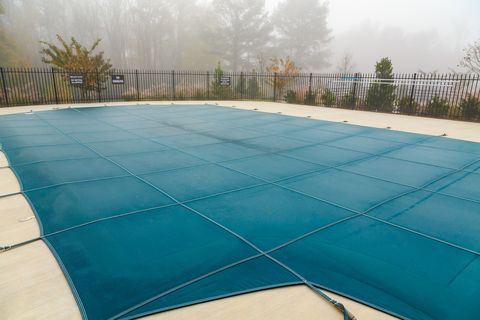How to Winterize Your Pool
Follow these simple steps to close down your pool for the cooler, darker months.
By Timothy Dahl
GETTY IMAGES/DBVIRAGO
The hardest part of shutting down your pool is… deciding to shut down your pool. You’re shutting down fun. (Think of the noodle jousting!) You’re shutting down waking up on a Saturday and immediately putting on a bathing suit. (The bathing suit as regular clothes!) You’re shutting down the thing where everyone has gone to bed, and you make yourself a drink and swim by yourself in total darkness.
Just us?
Anyway, the rest is easy. Technical but easy.
If you live in the Sunbelt or southern states, winterizing your pool doesn't require much extra work, and you can leave it uncovered if you like. But on the East Coast and in other (literally) freezing areas, you'll want to drain all pool filters and pumps, and shut everything down. Here's how to do it.
Check the Filters
The end of swimming season is the perfect time to check and clean (or replace) your pools cartridge filters. If you've got a diatomaceous earth (DE) filter, you'll need to continue your regular monthly maintenance, which includes backwashing, reloading DE, and a thorough filter clean at least once in the winter if you're not draining the pool. You don't want to go into winter with a dirty filter that is struggling to keep your pool clean. If you live in an area that can freeze, drain your filter, pump, and heater and consider blowing out the pipes using an air compressor or shop vac.
Skim, Scoop, and Brush
Although you won't be using the pool, it's important to keep skimming it and scooping up leaves, dirt, and any organic matter that falls in so long as it has water. It's easy to ignore the pool in winter, but a buildup will cause your filter to work harder and can lead to algae growth. A pool cover negates this extra work, but your pool should be completely free from contaminants before you cover it.
Regulate Your Chemicals
Even if you have a pool maintenance service, it's vital that you know how to check your pool's chemistry. The easiest way to do this is by using testing strips. Simply dip one into the water and compare the strips color to the chart on the container. The most important levels are chlorine, PH, and alkalinity. If one of these is out of range, take the necessary steps to fix it or contact your pool service.
If you're completely shutting down and covering your pool in the winter, make sure it's sparkling clean before you do.
Cover Your Pool
A pool cover can be used in the winter months to prevent contaminants from falling into your pool and also protects it from sunlight and algae. Your pool chemistry will also remain more stable when using a pool cover.
Lower Your Water Level
Use a water pump to lower the water level about a foot below the skimmer. Only do this if you are completely shutting down your pool for the winter. This will help you blow out any remaining water from your pools plumbing system so it doesn't freeze and cause cracks. A lower water level can also prevent cracks in tile if the water freezes.
Store Accessories
For a complete pool shut down, put all of your pool accessories in room temperature storage. This includes chlorine tablet containers, brushes, skim baskets, and poles. Freezing temperatures will shorten the life of anything plastic.
Your pool is now fully winterized and waiting for spring.
(You can keep wearing your trunks if you want.)
No comments:
Post a Comment